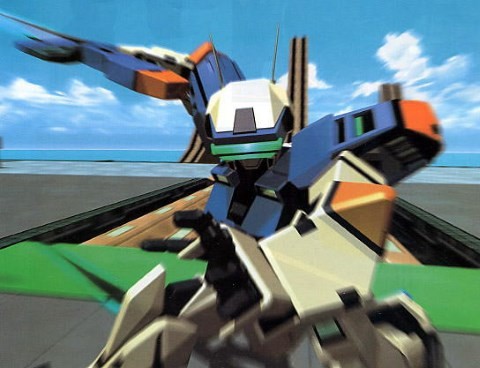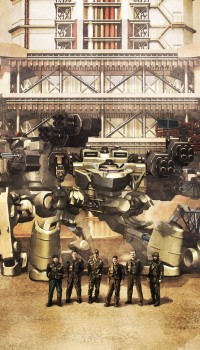Posted on : 17-03-2015 | By : Cacophanus | In : Features

We’ve tried to avoid doing these kinds of lists over the years. Mainly because they end up being contentious and misinterpreted. That said it’s about time we got around to doing this. Especially as other places have attempted similar lists and ended up being laughably parochial and clearly ignorant with it.
Before we start, there are a few a disclaimers. “Best” in this context means that these games are obviously great fun to play but they also went on to influence other games as well as approached mecha gaming in a unique way. They might have even resolved design issues that had plagued other titles too.
The games listed are also not necessarily based on our reviews either, as some we have yet to even cover, but more how they have defined mecha gaming over the years. These are also games that we regard to be very well wrought, based on our years of experience from playing lots and lots of mecha games.



Posted on : 29-08-2011 | By : Cacophanus | In : Features
 Back in 2001 From Software announced their support for Microsoft’s first foray into the console market. With games like Murakumo and Gaia Blade many of the Japanese press and public regarded the Xbox as a possible contender, after all this was a staunch Japanese developer making games for an American console. The thing was that whilst Murakumo was available shortly after the Xbox’s release in Japan, Gaia Blade disappeared into insignificance.
Back in 2001 From Software announced their support for Microsoft’s first foray into the console market. With games like Murakumo and Gaia Blade many of the Japanese press and public regarded the Xbox as a possible contender, after all this was a staunch Japanese developer making games for an American console. The thing was that whilst Murakumo was available shortly after the Xbox’s release in Japan, Gaia Blade disappeared into insignificance.
The promotional in-game movie for Gaia Blade that was shown at the 2001 Tokyo Game Show displayed a rather lush “real time simulation” RPG set in a mythical almost ancient Greek inspired landscape. A scantily clad female warrior dispensed with multiple beasts in a pretty brutal fashion.
Roll forward a year to the following Tokyo Game Show and now people were asking what had happened to Gaia Blade. This time there weren’t any in-game movies but instead a few instances of pre-production artwork. Again, set in the mythical world but now with bipedal mecha and the game’s name had been changed to that of Gaia Gear. Admittedly, very few were surprised to see mecha in a From Software game but they were confused after seeing in-game footage of what looked to be an entirely different type of game. The question on everybody’s lips was what in the hell was From Software doing?
A year later a game finally appeared, the name had changed yet again as had the setting but the same design of bi-pedal mecha were present; the world had finally been introduced to Chrome Hound: Age of Arms.



Posted on : 16-11-2009 | By : Cacophanus | In : Features
 As a developer GameArts are known most for their work on the wondrous Grandia games as well as their input to the Silpheed series, but they’ve also produced a rather well wrought selection of mecha games too.
As a developer GameArts are known most for their work on the wondrous Grandia games as well as their input to the Silpheed series, but they’ve also produced a rather well wrought selection of mecha games too.
Specifically, the four Gungriffon games that have graced multiple consoles over the years. These games pre-date From Software’s perennial Armored Core series but due to a number of factors, both cultural and financial, the games have never quite garnered the appreciation they so sorely deserved.
This is not to say that the Gungriffon games haven’t been critically lauded over the years but they haven’t reached the broader appeal that something like Heavy Gear did for instance, despite both series sharing similar base rulesets for the mecha. Amusingly, the design of mecha themselves has often been mistakenly attributed to be Western in origin, despite the obvious linkages to Ryosuke Takahashi’s VOTOMS series, something that again Heavy Gear shares. As such, we’ll delve into the series as a whole and examine what has made these games remain such a cult hit.



Posted on : 27-09-2009 | By : Cacophanus | In : Features
 A few years ago I was lucky enough to interview a then aspiring mecha designer by the name of Junji Okubo. At that point his work included games like Tekki (aka Steel Battalion) and the Gundam remake For The Barrel. His designs were unique as they depicted machines that looked almost palpably real. Since then Junji has worked on a few anime works, notably that of Appleseed Ex Machina and Viper’s Creed and also contributed to games such as Infinite Space. It seems that his work is finally garnering the appreciation it so sorely deserves.
A few years ago I was lucky enough to interview a then aspiring mecha designer by the name of Junji Okubo. At that point his work included games like Tekki (aka Steel Battalion) and the Gundam remake For The Barrel. His designs were unique as they depicted machines that looked almost palpably real. Since then Junji has worked on a few anime works, notably that of Appleseed Ex Machina and Viper’s Creed and also contributed to games such as Infinite Space. It seems that his work is finally garnering the appreciation it so sorely deserves.
Not long after this interview was conducted, Junji contacted me to let me know that he was publishing a book of his work and that could he use the interview I did. Naturally, I was happy to oblige. So the following interview is the English translation of the one you read in his book, Izmojuki Industrial Divinities.
Enjoy!



Posted on : 14-09-2009 | By : Cacophanus | In : Features
 Like many of my generation, I grew up watching a lot of cartoons. One of which was Transformers and like with many shows of that era many of my childhood friends owned the toys as well. We would play Autobots and Decepticons in our respective gardens, re-enacting the aeon long struggle between mechanical good and evil. Of all the mecha franchises birthed in Japan, Transformers is one that has the greatest amount of cultural common ground in the West; there’s an almost implicit understanding of how these fictional living machines operate.
Like many of my generation, I grew up watching a lot of cartoons. One of which was Transformers and like with many shows of that era many of my childhood friends owned the toys as well. We would play Autobots and Decepticons in our respective gardens, re-enacting the aeon long struggle between mechanical good and evil. Of all the mecha franchises birthed in Japan, Transformers is one that has the greatest amount of cultural common ground in the West; there’s an almost implicit understanding of how these fictional living machines operate.
Yet, for all this commonality the vast majority of the games that attempt to re-produce those afternoons of toy robot battling end up being disjointed and functionally quite fractured.
I’ve already covered something similar about the various Macross games, as that franchise has a very close mechanical linkage to Transformers, but the issue here isn’t a technical and logistical one but a cultural one in regards to the ability of learning from what has gone before.



Posted on : 08-09-2009 | By : Cacophanus | In : Features
 There are few games developers in the world that engender such a fan driven fervour as Treasure. Their games are revered in an almost monolithic sense, beacons of taut gaming functionality they distill the mechanics of a game into something palpably cogent. However, there are a few instances amongst their creative portfolio that have wider cultural leanings.
There are few games developers in the world that engender such a fan driven fervour as Treasure. Their games are revered in an almost monolithic sense, beacons of taut gaming functionality they distill the mechanics of a game into something palpably cogent. However, there are a few instances amongst their creative portfolio that have wider cultural leanings.
I am, of course, referring to Bakuretsu Muteki Bangai-O. A series of games featuring the titular mecha, Bangai-O, as it sprays a colourful 2D world with a vast array of homing missiles and lasers. The initial functional impetus for the game was outed as being that of the Sharp X1 title Hover Attack but in a more recent interview, this was merely a partial catalyst as it became clearer that the main influences took on a far greater role.
Specifically, three anime series were cited in the interview; Macross, Layzner and Ideon. For those that have been reading the column regularly, I’ve already covered the effect of each of these series (here and here). Now it’s time to see how these influences actually manifest themselves in a gaming series such as Bangai-O.



Posted on : 08-09-2009 | By : Cacophanus | In : Features
 In December of 1999, SEGA released a nigh-on arcade perfect port on their ill-fated Dreamcast for Virtual On Oratorio Tangram. Like the Saturn port of its precursor, it also featured a bespoke controller to emulate the arcade version’s original setup: a pair of twinsticks. It was critically lauded by almost all Japanese (and many Western) publications and did quite well in terms of sales too.
In December of 1999, SEGA released a nigh-on arcade perfect port on their ill-fated Dreamcast for Virtual On Oratorio Tangram. Like the Saturn port of its precursor, it also featured a bespoke controller to emulate the arcade version’s original setup: a pair of twinsticks. It was critically lauded by almost all Japanese (and many Western) publications and did quite well in terms of sales too.
The thing with the Virtual On series though is that they’ve always been focused around human multiplayer. In that regard they are practically peerless. As to their singleplayer “experience”; it’s almost been an oversight.
Even Hajime Katoki’s mecha design was forcibly restrained for the various Virtuaroids, as the 1995 original had very stringent polygon counts which set the aesthetic. The first two Virtual On games in fact are almost exercises in functional minimalism.
Yet Virtual On, as a series, has had a remarkable amount of design-based progeny over the years but in the case of Oratorio Tangram such “offspring” would only be a few years away.
Cue Hideo Kojima…



Posted on : 07-09-2009 | By : Cacophanus | In : Features
 I first played Virtual On years ago now, originally on the Saturn port in fact. I look back at that with some disdain admittedly, as I later but quickly realised that the arcade original, with its wondrous twinstick control setup, was a far superior game. The arcade version took me a few months of practice to get into, mainly because the nearest arcade was an hour’s train ride away and I was still at the tender age that meant I didn’t have a driving license.
I first played Virtual On years ago now, originally on the Saturn port in fact. I look back at that with some disdain admittedly, as I later but quickly realised that the arcade original, with its wondrous twinstick control setup, was a far superior game. The arcade version took me a few months of practice to get into, mainly because the nearest arcade was an hour’s train ride away and I was still at the tender age that meant I didn’t have a driving license.
Once I’d learnt the basics I decided to create a club in a fairly central London arcade (London being in the UK, in case you’re wondering). It was imaginatively titled the London Virtual On Club, or LonVOC for short.
It then appeared that my practice had been pretty thorough, as my subsequent skills were rather potent against the new club members (all of whom were keen to best me, but in the non-Xbox Live smacktalk sense). We were also later graced with the only arcade cabinet of Virtual On Oratorio Tangram (M.S.B.S. 5.2) in the UK, which was a lot of fun.
Considering the recent announcement of Oratorio Tangram coming to digital download, it seems only fair to cover a series that made me travel halfway across my native country just to plumb credits into an arcade cabinet (a cabinet I later ended up owning, as you probably know already).



Posted on : 07-09-2009 | By : Cacophanus | In : Features
 Here’s a low-down of a rather wonderful Japanese games developer by the name of Sandlot. Officially formed in March of 2001, they approached the genre of mecha gaming with quite literally a new perspective.
Here’s a low-down of a rather wonderful Japanese games developer by the name of Sandlot. Officially formed in March of 2001, they approached the genre of mecha gaming with quite literally a new perspective.
In 1953 a budding manga artist, by the name of Mitsuteru Yokoyama, penned a series that would be responsible for laying the foundations of a pop-cultural phenomenon that has now lasted over half a century. The series involved a young boy remote controlling a giant robot by the name of Tetsujin 28-go (translated as Iron Man 28 and released abroad as Gigantor). This focus of the boy controlling a huge mecha from ground level was clearly an inspirational one in the case of Sandlot’s genesis.
For almost all but one of Sandlot’s games they have a very similar gameplay implementation in regards to the player viewpoint, that of a boy on the ground looking up at an immense mechanical behemoth (or at the very least a discernable sense of scale to the gaming proceedings).
It’s also interesting to note that this mechanical inspiration has consequently spawned a more successful series of games.
More after the jump:



Posted on : 06-09-2009 | By : Cacophanus | In : Features
 In 1999 a developer renowned for its pedigree in creating driving simulators ventured into pastures where high speed mecha roam. The developer was Polyphony Digital, the game: Omega Boost for the original PlayStation.
In 1999 a developer renowned for its pedigree in creating driving simulators ventured into pastures where high speed mecha roam. The developer was Polyphony Digital, the game: Omega Boost for the original PlayStation.
It was possibly the most accomplished implementation of mecha themed space combat yet achieved.
The player had control over the titular mecha, the Omega Boost, and were able to acquire targets in spherical 3D at incredible speed. Considering the aesthetic influences from anime such as Macross, it was unsurprising that Shoji Kawamori helmed the mecha design with his regular finesse.
Many assumed that the game was an offshoot from Team Andromeda’s seminal Panzer Dragoon series, as the beautifully insane homing lasers were in similar effect. It became an almost apocryphal tale, that was supposedly wholly without credence.
Well, Yuji Yasuhara would probably disagree…









 A few years ago I was lucky enough to interview a then aspiring mecha designer by the name of
A few years ago I was lucky enough to interview a then aspiring mecha designer by the name of 

 In December of 1999, SEGA released a nigh-on arcade perfect port on their ill-fated Dreamcast for
In December of 1999, SEGA released a nigh-on arcade perfect port on their ill-fated Dreamcast for 
 Here’s a low-down of a rather wonderful Japanese games developer by the name of
Here’s a low-down of a rather wonderful Japanese games developer by the name of 







